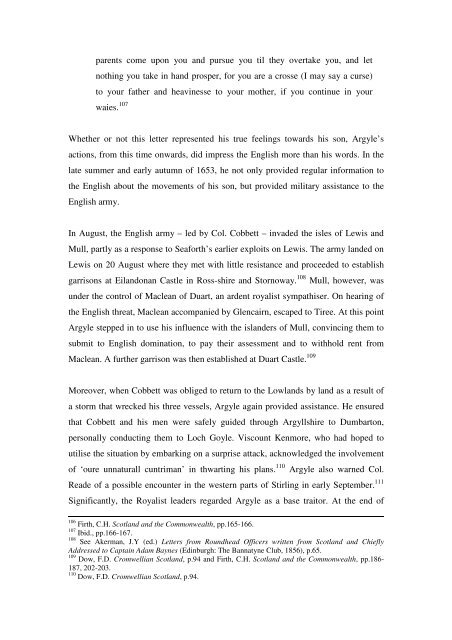The Glencairn Uprising, 1653-54 Helen Baker Department of ...
The Glencairn Uprising, 1653-54 Helen Baker Department of ...
The Glencairn Uprising, 1653-54 Helen Baker Department of ...
You also want an ePaper? Increase the reach of your titles
YUMPU automatically turns print PDFs into web optimized ePapers that Google loves.
parents come upon you and pursue you til they overtake you, and let<br />
nothing you take in hand prosper, for you are a crosse (I may say a curse)<br />
to your father and heavinesse to your mother, if you continue in your<br />
waies. 107<br />
Whether or not this letter represented his true feelings towards his son, Argyle’s<br />
actions, from this time onwards, did impress the English more than his words. In the<br />
late summer and early autumn <strong>of</strong> <strong>1653</strong>, he not only provided regular information to<br />
the English about the movements <strong>of</strong> his son, but provided military assistance to the<br />
English army.<br />
In August, the English army – led by Col. Cobbett – invaded the isles <strong>of</strong> Lewis and<br />
Mull, partly as a response to Seaforth’s earlier exploits on Lewis. <strong>The</strong> army landed on<br />
Lewis on 20 August where they met with little resistance and proceeded to establish<br />
garrisons at Eilandonan Castle in Ross-shire and Stornoway. 108 Mull, however, was<br />
under the control <strong>of</strong> Maclean <strong>of</strong> Duart, an ardent royalist sympathiser. On hearing <strong>of</strong><br />
the English threat, Maclean accompanied by <strong>Glencairn</strong>, escaped to Tiree. At this point<br />
Argyle stepped in to use his influence with the islanders <strong>of</strong> Mull, convincing them to<br />
submit to English domination, to pay their assessment and to withhold rent from<br />
Maclean. A further garrison was then established at Duart Castle. 109<br />
Moreover, when Cobbett was obliged to return to the Lowlands by land as a result <strong>of</strong><br />
a storm that wrecked his three vessels, Argyle again provided assistance. He ensured<br />
that Cobbett and his men were safely guided through Argyllshire to Dumbarton,<br />
personally conducting them to Loch Goyle. Viscount Kenmore, who had hoped to<br />
utilise the situation by embarking on a surprise attack, acknowledged the involvement<br />
<strong>of</strong> ‘oure unnaturall cuntriman’ in thwarting his plans. 110 Argyle also warned Col.<br />
Reade <strong>of</strong> a possible encounter in the western parts <strong>of</strong> Stirling in early September. 111<br />
Significantly, the Royalist leaders regarded Argyle as a base traitor. At the end <strong>of</strong><br />
106 Firth, C.H. Scotland and the Commonwealth, pp.165-166.<br />
107 Ibid., pp.166-167.<br />
108 See Akerman, J.Y (ed.) Letters from Roundhead Officers written from Scotland and Chiefly<br />
Addressed to Captain Adam Baynes (Edinburgh: <strong>The</strong> Bannatyne Club, 1856), p.65.<br />
109 Dow, F.D. Cromwellian Scotland, p.94 and Firth, C.H. Scotland and the Commonwealth, pp.186-<br />
187, 202-203.<br />
110 Dow, F.D. Cromwellian Scotland, p.94.
















